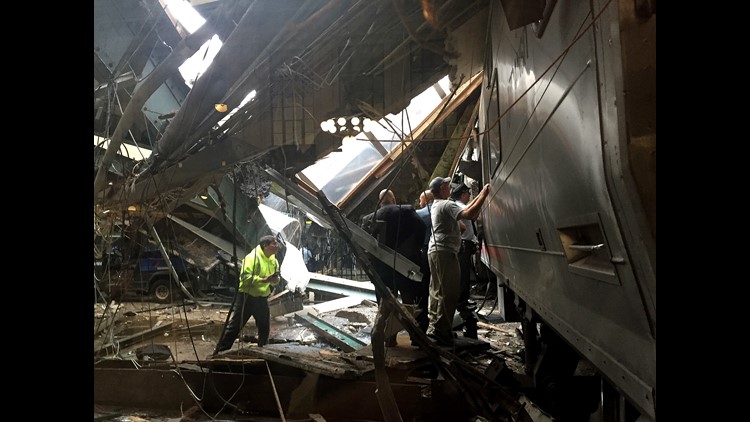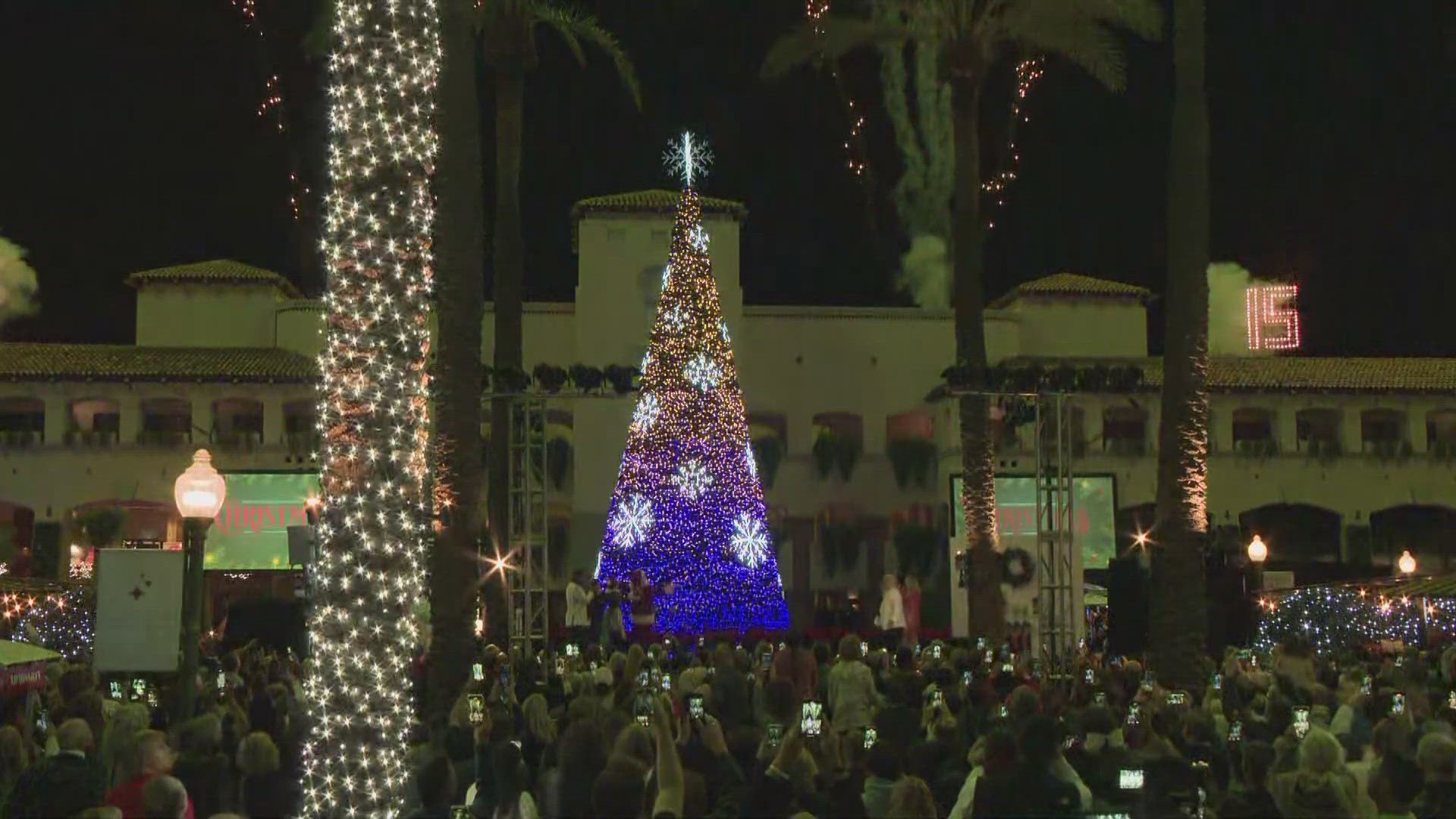At least one person was killed and scores were injured Thursday when a commuter train slammed into a rail station and crashed onto a concourse, authorities said.
Photos from the scene show a crumpled New Jersey Transit rail car at the battered station amid mangled steel, cables and concrete. The crash occurred during morning rush, at about 8:30 a.m. ET.
"The train came into the station at a high rate of speed and crashed through all the barriers," Gov. Chris Christie said. "This was an extraordinary tragedy."
Christie said it was too early to determine the cause of the crash. He said 108 people were injured, and that the lone fatality was a commuter standing in the station who was hit by debris from the crash. He said the train's engineer was injured but was cooperating with investigators.
Christie credited first responders and some passengers with rushing to the aid of the injured in the chaotic moments that followed the crash. Passenger Jamie Weatherhead-Saul said people on the train realized it was moving too fast as it approached the station.
“It didn’t stop. It didn’t slow down,” Weatherhead-Saul said. “The train just kept going.”
She said she was between the first and second cars and heard people screaming from the first car. She was shaken up but not injured and was able to exit the train after a conductor lifted an emergency latch.
The roof over the train platform collapsed, bringing rain water and live electrical wires into contact with the train and frustrating efforts to rescue people, said William Blaine, a rail engineer who was in the station at the time.
Mike Larson, a 29-year-employee of NJ Transit, said he was about 30 feet away from the train when it crashed. He said the train slammed into a bumper block at the end of the track, then roared onto the concourse. He tried to discourage passengers from kicking out windows to escape, warning them to wait until power was cut to the tangle of wires and cables exposed by the crash.
"I heard a bomb-like explosion... then the train was right in front of me," Larson said. "It was chaotic. It was pretty horrifying."
Chris Mann, 34, said he was less than 100 feet from the train when he heard the crash.
Unbelievable scene in Hoboken right now. Train crashed and went straight through the platform into the station. pic.twitter.com/NK2GDkkQA6
— Chris Lantero (@Chris_Lantero) September 29, 2016
“By the time I turned around and registered the train was coming, it had already completely crossed to the pedestrian walkway,” Mann said. “It all seemed to be very fast.”
Moments later he saw passengers climbing out from the train’s windows.
“People were crying and one woman … was bleeding,” Mann said. “The first responders were here very fast.”
Steve Mesiano, a passenger in the train's second car, told MSNBC the train was "going a little faster than it seemed it should have been going" as it pulled into the station.
"All of a sudden, there was just an impact, all the lights went out," Mesiano told the network. He said the first car jumped up onto the platform and it was hard to tell whether the injured were passengers or people outside on the platform.
"I saw a lot of people with gashed heads, there was blood on the floor, there was blood everywhere," Mesiano said.
All PATH service at the Hoboken station was suspended, but full PATH service was scheduled for the afternoon rush, the agency said. NJ Transit suspended service in and out of Hoboken and said its buses and private carriers were cross-honoring tickets and passes.
Federal Rail Administration officials arrived in Hoboken hours after the crash, the agency said. Bella Dinh-Zarr, vice chairman of the National Transportation Safety Board, said investigators will try to determine whether the lack of automatic braking might have been a factor in the crash.
Congress has set a 2018 deadline for adoption of the system. New Jersey Transit has said it expects to complete installation by 2018, but the railroad scores a zero for locomotives and track segments completed, according to a Federal Railroad Administration scorecard.
⚠️NJTransit Train Struck Hoboken Terminal. Major Structural Damage, Multiple Injuries. Expect Major Delays @PATHTrain
— Totally Hoboken (@TotallyHoboken) September 29, 2016
Photo by @ScotchWoodTy pic.twitter.com/RVbIcd6D01
Minutes after the accident, social media exploded with photos of the wreckage. The train slammed into an exterior wall of the terminal building, bringing down large sections of the roof that covers the train yard.
At Jersey City Medical Center, injured passengers are streaming into the cafeteria, which has been converted into a triage center. Some of the injured were brought in on an NJ Transit bus.
The passengers, wearing triage tags show the severity of their injuries, were being cared for by doctors and nurses. Some had cuts; some were in wheelchairs.
The hospital is expecting to treat 40 minor and 10 major injuries, said Mark Rabson, a hospital spokesman. The hospital has called in additional trauma doctors and nurses and sent numerous ambulances to the scene, he said.
“We have drilled for this for years,” Rabson said.
The train was on the Pascack Valley line, which runs from Hoboken through Hudson and Bergen counties in New Jersey and then into Rockland County in New York, terminating in Spring Valley.At the time of the train crash, skies were overcast, temperatures were in the low 60s with winds out of the north-northeast at 13-15 mph, according to National Weather Service weather stations at Newark and Central Park. No rain or thunderstorms were in the area.
Hoboken was the site of a serious crash in 2011. A PATH train struck a bumping post at the end of the track, and about 30 passengers, engineer and conductor were taken to hospitals with non-life-threatening injuries. Investigators determine that the engineer failed to control the speed of the train entering the station, and that the lack of automatic braking at the site contributed to the crash.
Hoboken, a city of more than 50,000 across the Hudson River from New York City, was pummeled by Hurricane Sandy in 2012. About 1,700 homes were flooded, resulting in $100 million in damage. Mayor Dawn Zimmer said at the time that the low-lying city filled up with water “like a bathtub.” Businesses were devastated, with many reporting a 60% drop in revenue, and transportation was disrupted with the closure of the PATH station connecting Hoboken and Manhattan.
Contributing: Susan Miller, Bart Jansen, Doug Stanglin



